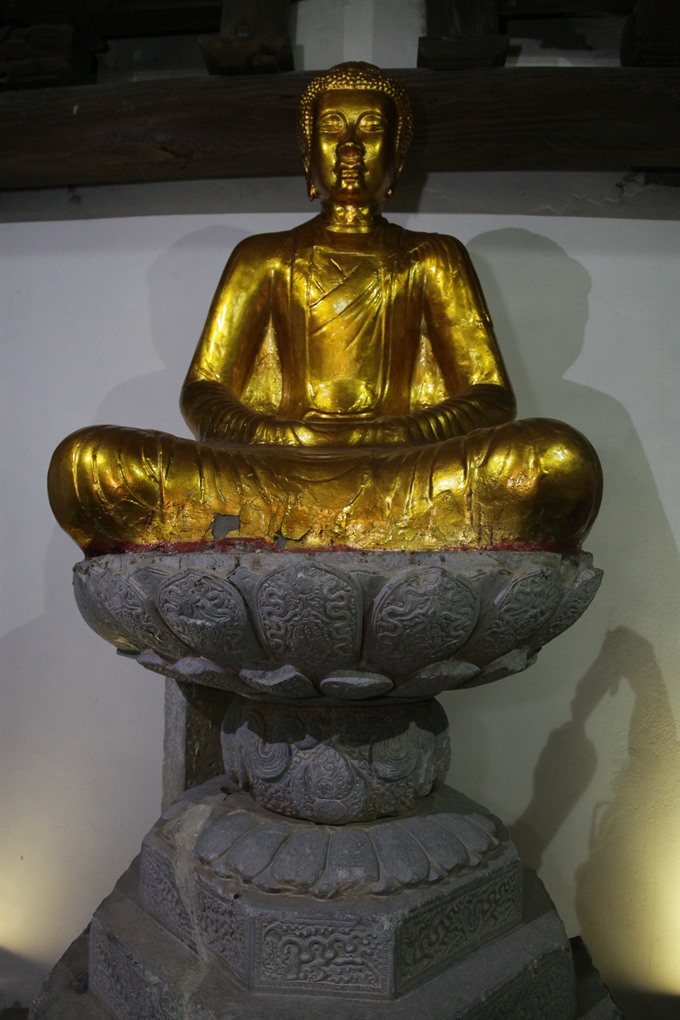

A special statue, of an Amitabha, has been popular since it was declared a national treasure. It is one of only five of the future Buddha that can still be seen today.
 |
| Piece of history: The original statue of the Việt people from 900 years ago. — VNS Photo Phạm Hoàng Văn |
A special statue, of an Amitabha, has been popular since it was declared a national treasure.
It is one of only five of the future Buddha that can still be seen today.
The statue was once in the mountains but it was brought down to the Ngô Xá Pagoda in Nam Định Province.
It dates back to the days of the Lý Dynasty.
By Nguyễn Mỹ Hà
To many first-time visitors, Hà Nội seems to be a young city not only because of so many young people out on its streets, but also because of new buildings and supermarkets, shops and restaurants, colleges and libraries. Thousands of new buildings have sprung up in the past 20 to 30 years.
Many people, particularly expatriates, find it hard to look into the 1,000-year-old history to find traces of the many dynasties that had their capitals up and down the Red River.
The architectural landmarks of distant dynasties, such as the Lý and Trần, are few and far between. So when a stone statue of Amitabha, the future Buddha, was declared a National Treasure, people jumped at the chance to see it.
The statue, which is housed at Ngô Xá Pagoda in Nam Định Province, is "said to be the oldest remaining complete stone statue of the Việt people from the Lý Dynasty", said history professor Trần Lâm Biền.
“We found it in the 1960s when we went to examine a collection of Chương Sơn relics,” he said. “The statue was originally up in the mountains, but people had carried it down to preserve it at the Ngô Xá Pagoda at the foot of the mountain.”
The Lý Dynasty started with founder Lý Công Uẩn, who later became King Lý Thái Tổ, who moved the royal capital from mountain-trapped Hoa Lư, to the flatland surrounding Đại La Citadel, where the Red River meets a busy residential and trading centre.
He named the new citadel Thăng Long, the Ascending Dragon, and started a dynasty that lasted for more than 200 years, that was militarily powerful and economically successful. Religion and art also bloomed.
Buddhist religion
Lý Công Uẩn grew up in a pagoda. During his life, Lý Thái Tổ, as he was known, was an observant Buddhist. Buddhism flourished under the dynasty.
It was written in the Đại Việt Sử Ký Toàn Thư, the Complete History of Great Việt, that the king ordered thousands of Buddhas be chiselled, thousands painted and tens of thousands of religious banners made.
It is written on a stone stele at Quỳnh Lâm Pagoda in Quảng Ninh Province, that a monk, Thượng Đức, carved a Buddhist statue 1m80 tall.
Author Nguyễn Tiến Cảnh writes in The Arts of Lý Dynasty published in 1973, “Buddhist towers and pagodas played a vital role under the Lý Dynasty. Then, pagodas were built everywhere in the country. Where there was man, there was pagoda. At beautiful scenic mountains and landscapes, there would be a pagoda built.”
Other Lý kings, Lý Thái Tông and Lý Nhân Tông, both took care of Buddhist and State affairs. Buddhism was actively practised, the teachings were wide-spread. Historian Lê Văn Hưu in the 13th century wrote that, “Over half of the population are monks and pagodas can be seen everywhere.”
Under the Lý Dynasty, a great number of pagodas and towers were built. Regent Queen Ỷ Lan built a total of 100 pagodas in her lifetime.
The country’s most influential Buddhist landmarks were built in the period. They included One Pillar Pagoda, the Celestial Tower in Thăng Long (now Hà nội), Phật Tích Pagoda and tower in Bắc Ninh Province and Chương Sơn Tower in Hà Nam Province.
The glorious epoch of the Lý Dynasty was later followed by the illustrious Trần Dynasty, both pivotal to the Việt civilization.
In the 15th century, the Ming from China invaded Đại Việt, as then Việt Nam today was named, and placed it under Chinese rule for 20 years. During this time they destroyed all the important landmarks of the Việt people.
They literally pulled down the towers and pagodas, destroyed statues and pavilions. They also burnt all the books.
Of all the magnificent pagodas and towers, palaces and residence, only five statues of Amitabha, the original treasures of the Lý Dynasty, remain for us to see today.
The oldest
And of all these five statues, the one at Ngô Xá Pagoda is the most complete. It was listed as a National Treasure in 2013.
“This is the most important statue, the Amitabha,” says historian Trần Lâm Biền. “It is the oldest. It’s unique.”
This year marks the 900th anniversary of the completion of the Chương Sơn Tower and we went to observe the statue, now preserved in the Ngô Xá Pagoda at the foot of Chương Sơn Mountains.
Started in the early days of spring 1108, the tower took nine years to complete.
King Lý Nhân Tông visited the Chương Sơn mountains in 1107, 1114 and 1117 — and each time a dragon is said to have appeared. According to Đại Việt Sử Ký Tòan Thư, or the Complete History of Great Việt Complete, “King Lý Nhân Tông ventured to Chương Sơn Mountains to inaugurate the Sacred Tower Vạn Phong Thành Thiện.”
During his reign, King Lý Nhân Tông warded off northern invaders and pacified southern neighbours. He reinforced the royal exams to choose talented scholars for royal postings. He banned the killing of buffaloes for meat to maintain farming capacity for rice cultivation. He built nine towers including twin towers with white tops in front of the Diên Hựu or One Pillar Pagoda in Hà Nội now.
But today, only the square stone foundation remains of the original Chương Sơn Pagoda. One side measures 19m long.
The Amitabha statue was originally placed in a 100-compartment pagoda standing by the tower. The statue was taken downhill from the mountains and now rests in Ngô Xá Pagoda, which was built in the 17th century.
Located at the foot of the mountains and further out of the town centre, Ngô Xá Pagoda is quiet and solemn. It stands in a large yard under age-old trees facing a rice field.
The sitting statue at Ngô Xá rests on a three-level stone pedestal. The lowest level shows water waves, dragons and flowers. The lower half of this level shows water wave after wave, above which lively dragons fly in between daisy flower strings. These motifs are quite popular and typical of the decoration in the Lý Dynasty.
The next level features a pair of lions playing with a jade ball on top of an inverted lotus. The lions sport little flowers on their bodies. The lotus petals are carved with chrysanthemum flowers.
The top level features a lotus bed with two layers of petals. Each petal bears a pair of dragons beautifully and lively carved.
All the ornate decorations lead to the most important statue on top. The whole statue and pedestal stand at 2m16.
The statue had a removable headpiece but it was stolen from the pagoda in 2002.
A country-wide police search was announced and all border gates checked. Nearly a year later, the head was found wrapped in a red piece of cloth, left in the commune’s cemetery.
Now if you visit the pagoda, you’ll see the statue clad in gold.
Nguyễn Văn Vinh, 80, a long time guard at the pagoda explained that the gilded coat was to hide the cut at the throat of the statue.
In a paper about Buddhism during the Lý Dynasty, historians Trần Lâm Biền and Chu Quang Trứ wrote that, “Only the statue at Ngô Xá Pagoda best represents the Buddhist human sculpture during the Lý Dynasty.”
The same paper also has it that, “The 100-compartment pagoda was beautifully carved with wood, but it was all gone.”
Pointing to a broken piece with water wave motifs, Nguyễn Văn Vinh says, “This is what is left of the border of the western hall at the 100-compartment pagoda up in the mountain.”
He then sighs, “It was huge.” — VNS
GLOSSARY
Many people, particularly expatriates, find it hard to look into the 1,000-year-old history to find traces of the many dynasties that had their capitals up and down the Red River.
Expatriates are people who live and work in a country that is not their home country.
Traces are clues.
Dynasties are families that rule a country for one generation after the next.
The architectural landmarks of distant dynasties, such as the Lý and Trần, are few and far between.
Architectural means to do with the design of buildings.
Landmarks are places that stand out in an area.
Distant means far away.
“We found it in the 1960s when we went to examine a collection of Chương Sơn relics,” he said.
Relics are things that are left behind from a long time ago.
“The statue was originally up in the mountains, but people had carried it down to preserve it at the Ngô Xá Pagoda at the foot of the mountain.”
To preserve something means to keep it in a good condition, especially if it has a good chance to get worse if it is not cared for properly.
The Lý Dynasty started with founder Lý Công Uẩn, who later became King Lý Thái Tổ, who moved the royal capital from mountain-trapped Hoa Lư, to the flatland surrounding Đại La Citadel, where the Red River meets a busy residential and trading centre.
A residential centre is a place where people have their homes.
Religion and art also bloomed.
Bloomed means flowered. In this case, it means religion and art would have looked good the way plants look when they are in flower.
Lý Công Uẩn grew up in a pagoda. During his life, Lý Thái Tổ, as he was known, was an observant Buddhist. Buddhism flourished under the dynasty.
To be observant means to follow a religion faithfully.
If Buddhism flourished, it became strong and people were practising the religion.
It was written in the Đại Việt Sử Ký Toàn Thư, the Complete History of Great Việt, that the king ordered thousands of Buddhas be chiselled, thousands painted and tens of thousands of religious banners made.
If a statue of Buddha is chiselled it is carved using a tool called a chisel.
It is written on a stone stele at Quỳnh Lâm Pagoda in Quảng Ninh Province, that a monk, Thượng Đức, carved a Buddhist statue 1m80 tall.
A stele is a piece of upright stone used to remember something or somebody.
Author Nguyễn Tiến Cảnh writes in The Arts of Lý Dynasty published in 1973, “Buddhist towers and pagodas played a vital role under the Lý Dynasty.”
To play a vital role means to play an important part.
The country’s most influential Buddhist landmarks were built in the period.
Influential means convincing and powerful.
The glorious epoch of the Lý Dynasty was later followed by the illustrious Trần Dynasty, both pivotal to the Việt civilization.
An epoch is a time in history.
Pivotal means important.
They literally pulled down the towers and pagodas, destroyed statues and pavilions.
Literally means “as it is said”. In other words the towers and pagodas were actually pulled down.
“It’s unique.”
If something is unique there is only one of it.
This year marks the 900th anniversary of the completion of the Chương Sơn Tower and we went to observe the statue, now preserved in the Ngô Xá Pagoda at the foot of Chương Sơn Mountains.
An anniversary is a day that marks any number of years after something happened.
King Lý Nhân Tông visited the Chương Sơn mountains in 1107, 1114 and 1117 — and each time a dragon is said to have appeared. According to Đại Việt Sử Ký Tòan Thư, or the Complete History of Great Việt Complete, “King Lý Nhân Tông ventured to Chương Sơn Mountains to inaugurate the Sacred Tower Vạn Phong Thành Thiện.”
To inaugurate the tower means to open it for the first time.
During his reign, King Lý Nhân Tông warded off northern invaders and pacified southern neighbours. He reinforced the royal exams to choose talented scholars for royal postings.
A reign is the time during which someone is the ruler.
He banned the killing of buffaloes for meat to maintain farming capacity for rice cultivation.
To have the capacity to farm rice means to be able to do it.
The Amitabha statue was originally placed in a 100-compartment pagoda standing by the tower. The statue was taken downhill from the mountains and now rests in Ngô Xá Pagoda, which was built in the 17th century.
Compartments are little rooms.
Located at the foot of the mountains and further out of the town centre, Ngô Xá Pagoda is quiet and solemn.
Solemn means formal and serious.
The sitting statue at Ngô Xá rests on a three-level stone pedestal.
A pedestal is a support base.
These motifs are quite popular and typical of the decoration in the Lý Dynasty.
Motifs are designs.
The next level features a pair of lions playing with a jade ball on top of an inverted lotus.
Inverted means turned the other way around.
The lions sport little flowers on their bodies.
Sport, in this case, means “have placed on them”.
A country-wide police search was announced and all border gates checked. Nearly a year later, the head was found wrapped in a red piece of cloth, left in the commune’s cemetery.
A cemetery is a graveyard.
Now if you visit the pagoda, you’ll see the statue clad in gold.
Clad means dressed.
Nguyễn Văn Vinh, 80, a long time guard at the pagoda explained that the gilded coat was to hide the cut at the throat of the statue.
Gilded means covered in a thin layer of gold.
He then sighs, “It was huge.”
A sigh is a long breath that you give to show that you are tired, sad or relieved.
WORKSHEET
State whether the following sentences are true, or false:
© Duncan Guy/Learn the News/ Viet Nam News 2017
1. False; 2. True; 3. False; 4. True; 5. True.






.jpg)


